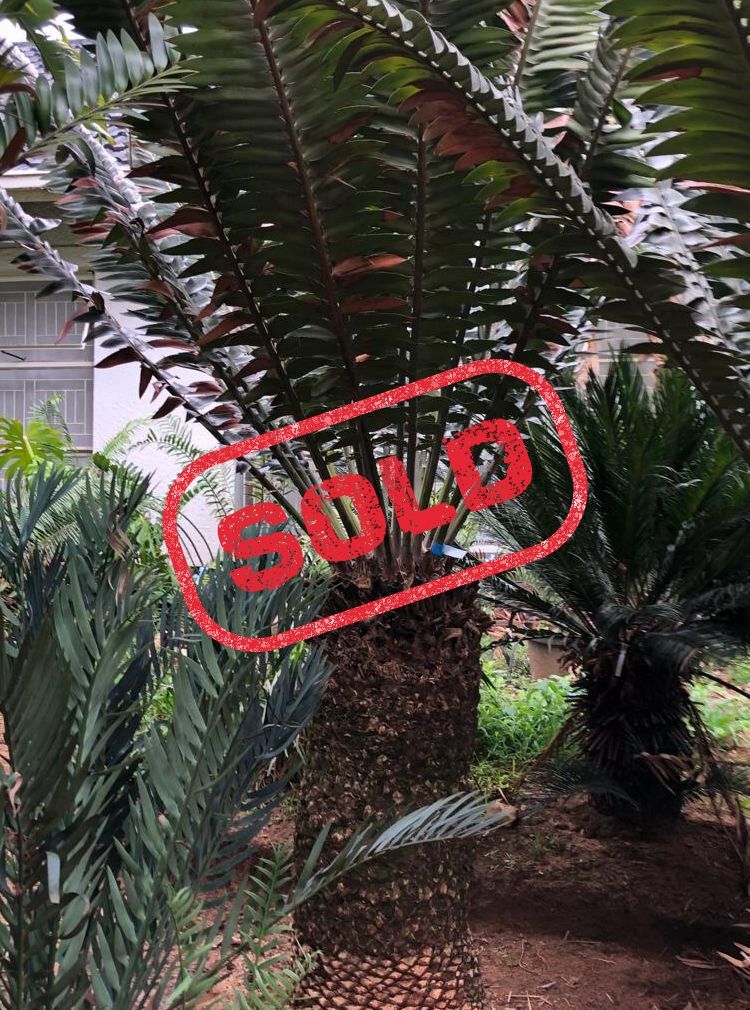|
| Division: Cycadophyta |
| Class: Cycadopsida |
| Order: Cycadales |
| Family: Zamiaceae |
| Genus: Encephalartos |
| Species: E. transvenosus |
Conservation Status: |

E. transvenosus
Modjadji CycadEncephalartos transvenosus occurs intermittently over a large area in the Limpopo Province, South Africa. In the south the distribution starts in the northern parts of the Drakensberg mountain range. Further northwards a large isolated subpopulation is found in the Modjadji Nature Reserve. The distribution is then taken up in the Soutpansberg mountains. It extends over most of this mountain range and continues further east to the middle of the Thohoyandou area. Recorded from elevations ranging from 600 to 1,500 m . All localities of E. transvenosus are on mountain mistbelt zones. Plants grow in tall grassveld and mixed bushveld, mainly on steep rocky slopes facing southeast.
As a garden subject, Encephalartos transvenosus, with its glossy dark-green leaves, is one of the most spectacular and tallest of all cycad species. It is also one of the fastest growing, the seedlings growing rapidly and developing into an attractive garden plant with 1-m long leaves in four to five years.
The stem reaches a height of 12 to 13 m and 0.4-0.45 m in diameter. Typical of the species is the appearance of numerous dormant buds along the base of the stem. The new leaves are light green covered with fine brown hairs, while the mature leaves develop to from 1.5 to 2.5 m in length and are dark green and glossy. The leaflets, attached to the leaf stalk, are 160-250 x 25-45 mm, but reduce in size closer to the base of the leaf stalk. The leaflets overlap and a distinguishing feature is that these leaflets are reflexed from the leaf stalk.
This species is regarded as a tree as it develops to a height of 6 to 8 m or more with a leaf spread of up to 5 m. Being a gymnosperm, these plants produce cones. They are dioecious, which means male and female cones are produced on separate plants. Male cones develop to a length of 300-400 mm; the female cones are very large and heavy. The cones are golden brown in colour and are produced in late summer, weighing more than 40 kg.
Generally cycads are regarded to be slow-growing; however, given ideal growing conditions, this species will, in five years, develop into a worthwhile garden subject with leaves of at least a metre in length. All cycads are regarded as being long-lived, surviving for hundreds of years.
Cultivation:
Encephalartos transvenosus is one of the most attractive of the larger cycad species and responds well to cultivation in frost-free areas, with regular watering in the dry months. Good drainage is essential and protection from sun in very hot areas will help to prevent the leaves from burning.
Adapts well to full sun or light shade and prefers a sheltered position providing protection from the prevailing winds. When young they can be grown as a container plant and eventually transplanted into the garden. This species transplants easily as a mature plant, although it is recommended to remove all the leaves before doing so. This makes for easier handling and the plant will recover sooner due to less moisture loss.
Irrigation systems can be detrimental to cycads, damaging the leaves and stems from the pressure of the water as well as over-watering.
| semi-shade | dark green | low watering | fast growth | frost-resistant | common |
Encephalartos transvenosus is one of the most attractive of the larger cycad species and responds well to cultivation in frost-free areas, with regular watering in the dry months. Good drainage is essential and protection from sun in very hot areas will help to prevent the leaves from burning.
Adapts well to full sun or light shade and prefers a sheltered position providing protection from the prevailing winds. When young they can be grown as a container plant and eventually transplanted into the garden. This species transplants easily as a mature plant, although it is recommended to remove all the leaves before doing so. This makes for easier handling and the plant will recover sooner due to less moisture loss.
Irrigation systems can be detrimental to cycads, damaging the leaves and stems from the pressure of the water as well as over-watering.
E. transvenosus for sale at AfricaCycads.com:
|
|


